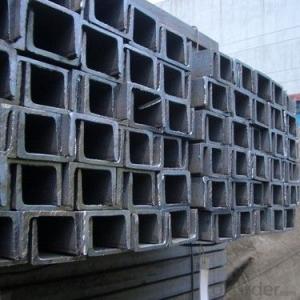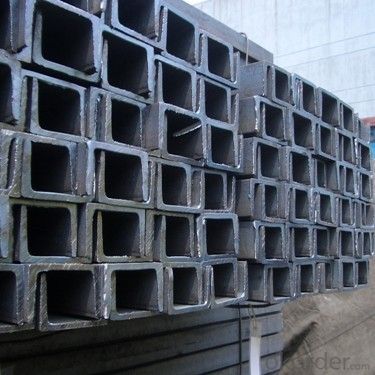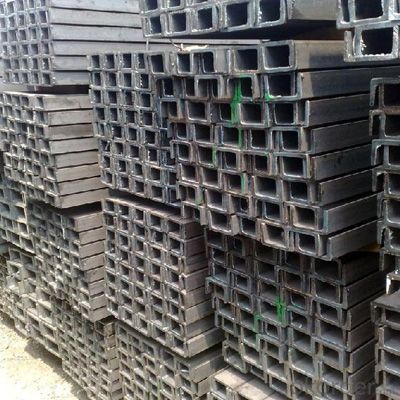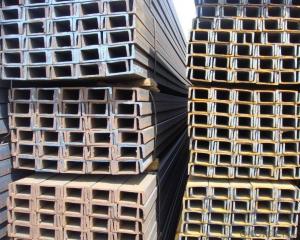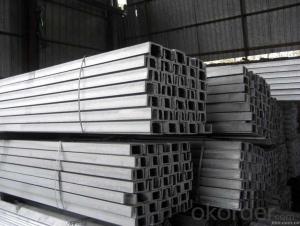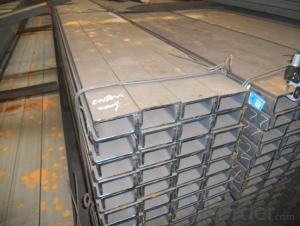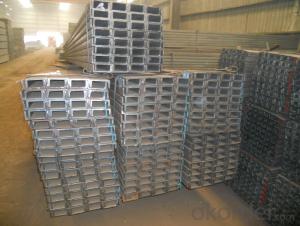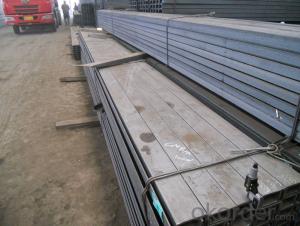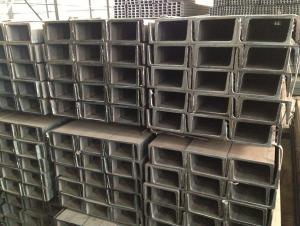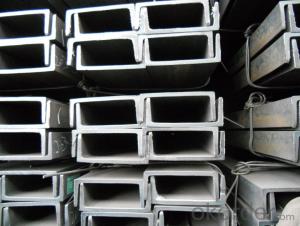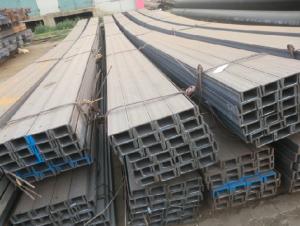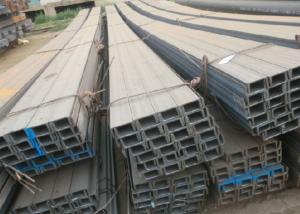High Quality JIS Steel Channel
- Loading Port:
- China Main Port
- Payment Terms:
- TT OR LC
- Min Order Qty:
- -
- Supply Capability:
- -
OKorder Service Pledge
OKorder Financial Service
You Might Also Like
Steel Channel
Standard: JIS
Material: SS400
Length: 6m, 12m
Size:
| Size (mm) | Mass (Kg/m) |
| 50*25*3.0 | 2.37 |
| 70*40*4.0 | 5.60 |
| 75*40*4.5 | 5.85 |
| 75*40*5.0 | 6.92 |
| 100*50*4.5 | 8.97 |
| 100*50*5.0 | 9.36 |
Package & Delivery of Steel Channel:
1.The hot rolled channel steel will be packed in bundle with steel wire at each end of every bundle and color marking in order to help the customer to recognize his goods more easily at sight.
2. And the hot rolled channel steel could be loaded into 20ft or 40ft container, or by bulk cargo.If the weight of each bundle reaches more than 3.5 mt, the loading by break bulk cargo should be choosed.When the weight of each bundle reaches less than 3mt, the loading by container should be choosed.
3.As for the transportaion from mill to loading port, the truck will be usually used. And the maximum quantity for each truck is 40mt.
4.All in all, we could do in accordance with customer's request.
Production Flow of JIS Channel:
1.The steel billet shall be heated in the high temperature furnace.
2. The heated steel billet shall be rolled five to nine times with the aim of shaping the general figure of steel u channel.
3. The rolled steel channel should be put onto the cooling bed to make the temperature low.
4. The JIS Channel should be straighted on the straightener.
5. The straighted steel u channel will be cut into meters by saw, as per customer's requirements.
6. At the last part of production, the channel steel must be tested in order to confirm that the finished products are completely free from crack, pore, slag, scab or fold on the surface.
*If you would like to get our price, please inform us the size, standard/material and quantity. Thank you very much for your attention.
- Q: Can steel channels be used in the renewable energy sector?
- Yes, steel channels can be used in the renewable energy sector. Steel channels are versatile and durable structural components that can be used in various renewable energy applications, such as supporting solar panel arrays, constructing wind turbine towers, or building infrastructure for hydroelectric power plants. Steel channels provide strength and stability, making them suitable for withstanding the challenging conditions often encountered in the renewable energy sector.
- Q: How do steel channels perform under wind loads?
- Construction and engineering projects often utilize steel channels to provide stability and structural support. Steel channels excel in resisting wind loads due to their strength and rigidity. Wind loads exert forces on structures, including uplift and lateral forces. Steel channels possess high tensile strength, enabling them to withstand these forces without significant deformation or failure. These channels are designed to effectively distribute and transfer wind forces to the foundation or other structural elements. The performance of steel channels under wind loads is also influenced by their shape and cross-sectional design. The profile of a steel channel efficiently dissipates wind energy, reducing the risk of structural damage or failure. The open design of these channels minimizes wind resistance, further enhancing their ability to withstand wind loads. Furthermore, steel channels can be customized and engineered to meet specific wind load requirements based on geographic location. Engineers consider factors such as wind speed, direction, and exposure to determine the optimal size, shape, and spacing of steel channels. In conclusion, steel channels are highly dependable and effective in withstanding wind loads. Their high tensile strength, shape, and customization options make them an excellent choice for structures exposed to strong winds. Whether it be a bridge, building, or any other construction project, steel channels offer the necessary support and stability to withstand wind loads and maintain the structural integrity of the entire system.
- Q: Can steel channels be used for retaining walls?
- Yes, steel channels can be used for retaining walls. Steel channels offer several advantages for retaining walls, including their high strength, durability, and resistance to corrosion. They are capable of withstanding heavy loads and can be easily customized to meet specific design requirements. Additionally, steel channels provide a long-lasting solution for retaining walls and can be used in a variety of applications, such as commercial, industrial, and residential projects. However, it is important to consider factors such as soil conditions, drainage, and engineering requirements when selecting and designing a steel channel retaining wall to ensure its effectiveness and stability.
- Q: How do steel channels contribute to the sustainability of a building?
- There are several ways in which steel channels contribute to the sustainability of a building. To begin with, steel channels are produced using recycled steel. This reduces the demand for new raw materials and minimizes the environmental impact of mining and extraction processes. By utilizing recycled steel, the carbon footprint of a building is significantly reduced compared to the use of traditional construction materials. In addition, steel channels have a long lifespan and are highly durable. They are resistant to corrosion, fire, and pests, requiring minimal maintenance over the lifetime of a building. This durability reduces the need for frequent replacements or repairs, saving resources and reducing waste. Moreover, steel channels offer design flexibility and can be easily fabricated and assembled, allowing for efficient construction processes. This leads to reduced construction time and energy consumption, resulting in lower costs and a reduced environmental impact. Furthermore, steel channels are lightweight, making them easier to transport and handle. This reduces fuel consumption during transportation and contributes to a more sustainable supply chain. Lastly, steel channels can be recycled at the end of their life cycle, further reducing waste and conserving resources. The recycled steel can be used to manufacture new steel products, creating a closed-loop system that minimizes the need for new extraction and production. In conclusion, steel channels contribute to the sustainability of a building through their use of recycled materials, long lifespan and durability, design flexibility, lightweight nature, and recyclability. Their environmental benefits make them an eco-friendly choice for construction, helping to reduce the overall environmental impact of buildings and promote a more sustainable future.
- Q: The reinforced welding off? Can the channel steel locked with expansion screws be taken out?
- The cutting machine can be used to make the welding areas thin and then knock. We used to be like this in the factory. So knock down and nothing will go wrong
- Q: Do steel channels have any specific vibration damping properties?
- Steel channels do not have specific vibration damping properties. However, the inherent stiffness and mass of steel channels can help absorb and dissipate vibrations to some extent. Additional measures such as using rubber or elastomer pads between steel channels and other vibrating components can further enhance their vibration damping capabilities.
- Q: Can steel channels be used in seismic design?
- Yes, steel channels can be used in seismic design. Steel channels, also known as steel C channels or C beams, are commonly used in seismic design due to their strength, stability, and ductility. In seismic design, the goal is to ensure that structures can withstand the forces generated during an earthquake. Steel channels are often used as structural members in seismic-resistant building systems due to their ability to absorb and dissipate energy. They have high load-carrying capacity, excellent bending and torsional resistance, and can effectively resist lateral forces caused by seismic activity. Additionally, steel channels can be designed and fabricated to meet specific seismic design requirements, such as using thicker steel plates or adding additional reinforcement. Overall, steel channels are a versatile and reliable choice for seismic design applications.
- Q: Can steel channels be used in solar panel installations?
- Yes, steel channels can be used in solar panel installations. Steel channels, also known as steel C channels or steel U channels, are commonly used in construction and industrial applications for their strength, durability, and versatility. When it comes to solar panel installations, steel channels can be used as support structures for mounting solar panels on rooftops or in ground-mounted systems. Steel channels provide a stable and robust framework that can withstand the weight of solar panels and withstand various weather conditions. They can be easily customized and fabricated to meet specific installation requirements, such as the size and angle of the solar panels. Additionally, steel channels can be galvanized or coated to provide corrosion resistance, ensuring the longevity of the solar panel installation. Furthermore, steel channels offer flexibility in terms of design and layout. They can be easily integrated with other mounting systems and components, such as rails, brackets, and clamps, allowing for efficient and secure solar panel installations. The adaptability of steel channels makes them suitable for both residential and commercial solar panel projects. In conclusion, steel channels are a viable option for solar panel installations due to their strength, durability, versatility, and compatibility with other mounting systems. They provide a solid foundation for mounting solar panels, ensuring a stable and efficient solar energy system.
- Q: How are steel channels installed in construction projects?
- Construction projects often utilize steel channels for their strength and versatility. To ensure proper alignment and stability, the installation of steel channels involves a series of steps. Firstly, architects, engineers, and construction teams coordinate to determine the location and layout of the steel channels based on project specifications and structural design. This requires meticulous planning. Next, the designated areas for steel channel installation are prepared. This may involve clearing the site, leveling the ground, and providing a stable foundation. Excavation or backfilling may also be necessary. Once the site is ready, the steel channels are delivered to the construction site. These channels are typically pre-fabricated with the required dimensions and specifications. Cranes or other lifting equipment are used to transport them to the installation area. Before installation, the construction team ensures that the steel channels are clean and free from debris or contaminants. This is crucial for proper bonding and stability during the installation process. The installation begins by aligning the steel channels in their designated positions. Laser levels, plumb bobs, or other alignment tools are used to ensure accurate placement. Clamps or braces are temporarily used to secure the channels in place. To permanently fix the steel channels, welding or bolting methods are typically employed. Skilled welders carefully join the channels to other structural elements, ensuring strong and durable connections. If welding is not feasible, bolts or screws may be used for securing the steel channels. Holes are drilled through the channels and corresponding structural elements, and bolts or screws are inserted and tightened to create a secure connection. Throughout the installation process, quality control measures are implemented to ensure correct installation. Inspections, measurements, and testing are conducted to verify alignment, levelness, and structural integrity. Once all the steel channels are installed, they undergo inspection for any defects or imperfections. Adjustments or repairs are made if necessary to meet the required standards and specifications. In summary, the installation of steel channels in construction projects requires careful planning, preparation, alignment, and secure attachment to other structural elements. Following proper installation procedures and implementing quality control measures is crucial for ensuring the channels provide the necessary structural support and stability.
- Q: How do steel channels contribute to the overall versatility of a structure?
- A structure's overall versatility is enhanced in multiple ways by steel channels. First and foremost, the exceptional strength and durability of steel channels enable them to support heavy loads and withstand various environmental conditions. This grants designers and engineers the freedom to construct structures with greater flexibility and creativity. Furthermore, the wide range of sizes and shapes available in steel channels allows for precise customization to meet the specific requirements of a structure. The availability of various types of channels, such as C-channels, U-channels, and J-channels, empowers engineers to select the most suitable member for different applications. In addition, steel channels can be easily connected and combined with other steel components, including beams and columns, to create intricate and efficient structural systems. Their compatibility with other steel elements enhances the overall strength and stability of the structure, ensuring its longevity and safety. Moreover, steel channels can be fabricated and installed with relative ease, resulting in faster construction times and cost savings. The versatility of steel channels enables efficient construction methods, such as bolted connections or welding, which can be adjusted to meet project requirements and site conditions. Finally, steel channels are readily available and can be sourced from numerous suppliers, making them a cost-effective choice for construction projects. The abundance of steel channels in the market ensures easy access, facilitating their integration into a wide variety of structures. In conclusion, steel channels contribute to a structure's overall versatility through their strength, customization options, compatibility with other steel components, ease of fabrication and installation, and cost-effectiveness. These factors establish steel channels as an essential element in modern construction, enabling the creation of versatile and efficient structures.
Send your message to us
High Quality JIS Steel Channel
- Loading Port:
- China Main Port
- Payment Terms:
- TT OR LC
- Min Order Qty:
- -
- Supply Capability:
- -
OKorder Service Pledge
OKorder Financial Service
Similar products
Hot products
Hot Searches
Related keywords
